| Bid Name | Bid Description | Example |
|---|
| High Card | This is a bid indicating a high card amongst all the community cards | 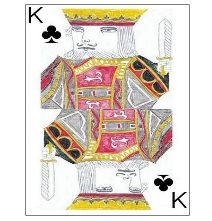 | | King high |
|
| One Pair | Two cards of the exact same rank | 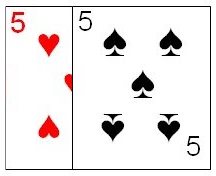 | | A pair of fives |
|
| Two Pair | Two cards of the same denomination and two other cards of another matching denomination | 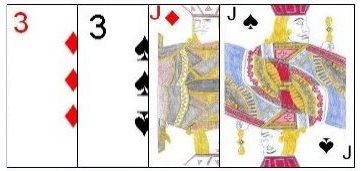 | One pair of threes
and one pair of Jacks |
|
| Three of a Kind | Three cards of the exact same denomination | 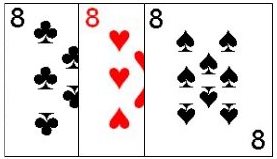 | | Three eights |
|
| Straight | Five cards all in sequence. The denomination of the high and low card in the sequence must be named. | 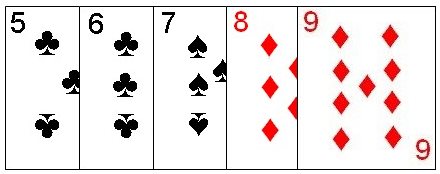 | | Straight of five to nine |
|
| Full House | A set of three equally ranked cards and another set of two equally ranked cards. | 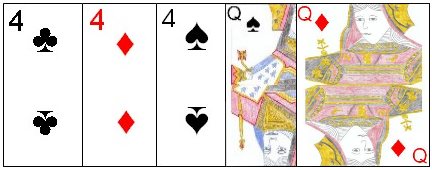 | Full House consisting of
three fours and two Queens |
|
| Four of a Kind | Four cards all of the same denomination | 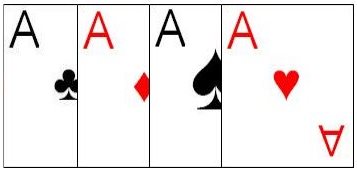 | | Four Aces |
|
| Five of a Kind | Five cards of the same denomination. This would obviously need to include at least one wild card | 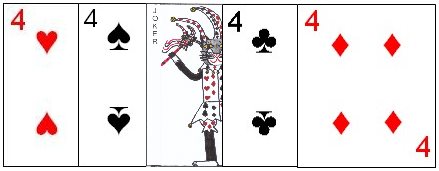 | | Five fours |
|
| Bid Name | Bid Description | Example |
|---|
| High Card | This is a bid indicating no other combinations, stating the ranking of the highest card in the hand | King high |
| One Pair | Two cards of the exact same rank | "One pair" or "Two fours" |
| Two Pair | Two cards of the same denomination and two other cards of another matching denomination | "Two
pairs" or "A pair of fives and a pair of eights" |
| Three of a Kind | Three cards of the exact same denomination | "Three of a kind" or "Three eights, a five, and a King" |
| Straight | Five cards all in sequence but not in the same suit | "Straight" or "Straight of four to nine" |
| Flush | Five cards all of the same suit but not in sequence | "Flush" or "Flush with highest card a Queen" |
| Full House | A set of three equally ranked cards and another set of two equally ranked cards. | "Full House" or "Three Kings and two Jacks" |
| Four of a Kind | Four cards all of the same denomination | "Four of a
kind" or "Four eights and a nine" |
| Straight Flush | Five cards in direct sequence and of the same suit. | "Straight Flush" or "Straight Flush three to eight" |
| Five of a Kind | Five cards of the exact same denomination. This would need to include at least one wild card. | "Five of a
kind" or "Five tens" |
| Combination | Description | Announcing | Example Announcement |
|---|
| Straight Flush | This is a series of five cards, all of the same suit and in direct sequential order. In comparing two such announcements of a Straight Flush, the higher such announcement would consist of the combination with the highest top card in the straight. | The player must state the suit of the straight flush and the specific rank of the highest card in the straight flush. | Straight flush in clubs, Queen high. |
| Four of a Kind | This consists of exactly four cards all of the exact same rank. If two such four of a kinds are to be announced and compared, the higher is one consisting of four higher ranked cards. | The player must state the specific rank of his four of a kind. | Four tens. |
| Full House | This combination consists of three cards all of the same rank, and two other cards which are of matching rank. In comparing two such announcements of this combination, the higher is that which consists of a higher three of a kind. If the three of a kinds are announced of an equal rank, the higher is that with a higher pair. | In announcing this combination the player must state the rank of both the triplet and that of the pair. | Triplet of eight and pair of threes. |
| Flush | A flush is five cards, not in direct sequential order, but all of the same suit. In comparing two such combinations of flushes, the highest is that containing the highest ranked
individual cards. | In announcing this combination, the player must state the suit of the flush and the specific ranks of the cards comprising it. | Flush of Diamonds, consisting of Ace, King, nine, four and two. |
| Straight | A straight is five cards, in direct sequential order, but not all of the same suit. In comparing two such announced combinations, the highest is that which has the highest top card. | In announcing this combination, the player must state the rank of the highest card in the straight. | Straight, Ace high. |
| Triplet (Three of a Kind) | This is a combination consisting of five cards, of which three of those cards are all of the same rank. In comparing two such announcements of this combination, the higher is that with the highest such three of a kind. | In announcing this combination, the player must state the specific rank of cards of the triple. | Triplet of tens. |
| Two Pair | This is a combination of five cards in which there are two sets of two matching cards, and one unmatched card. In comparing multiple announcements of such a hand, the higher is that consisting of the highest pair. If the highest announced pair is equal, the second highest pair is compared. | In announcing this combination, the player must state the specific rank of each pair. | Pair of Jacks and pair of fours. |
| One Pair (Two of a Kind) | This is a combination consisting of one pair of cards, and three other unmatched cards. Two such announcements can be compared with the higher such pair considered the higher ranked. | In announcing this combination, the player must state the specific rank of the pair. | One pair of nines. |
| High Card | This is a combination which consists of no matched cards and the five cards are not all of the same suit and not in direct sequential order. In comparing two such announced combinations of this type, the announced high card is compared. | In announcing this combination the player simply states what denomination the high card is. | High card King. |
Copyright © 2015 CatsAtCards.com. All rights reserved.








 Commune is a fun and unique game which can be great fun for large groups. The game appears to have gotten it's name because every player's cards are considered community cards, and are considered to be members of every player's hand.
Commune is a fun and unique game which can be great fun for large groups. The game appears to have gotten it's name because every player's cards are considered community cards, and are considered to be members of every player's hand.
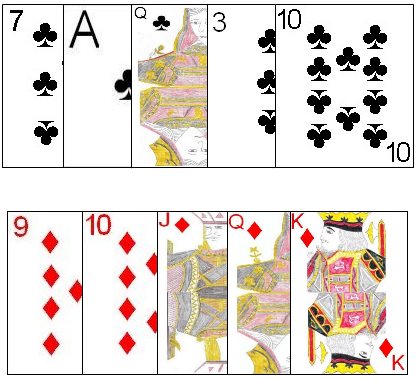 After the player makes his bid, the next player in a clockwise rotation then has two options:
After the player makes his bid, the next player in a clockwise rotation then has two options:
 Once a player shouts "Bluff" all the players expose their cards, placing
them in the middle of the table, face-up. If the last, highest announced hand
can indeed be formed from all the combined, exposed cards, the player who called
"Bluff" loses the hand. However, if the announced hand cannot be formed with the
player's exposed cards on the table the player who announced that combination
loses the hand. All the cards are then shuffled back into the pack, and the next
dealer then deals out the next hand. The loser of the hand will receive
one additional card on the next hand than that player had been dealt on the
prior hand.
Once a player shouts "Bluff" all the players expose their cards, placing
them in the middle of the table, face-up. If the last, highest announced hand
can indeed be formed from all the combined, exposed cards, the player who called
"Bluff" loses the hand. However, if the announced hand cannot be formed with the
player's exposed cards on the table the player who announced that combination
loses the hand. All the cards are then shuffled back into the pack, and the next
dealer then deals out the next hand. The loser of the hand will receive
one additional card on the next hand than that player had been dealt on the
prior hand.